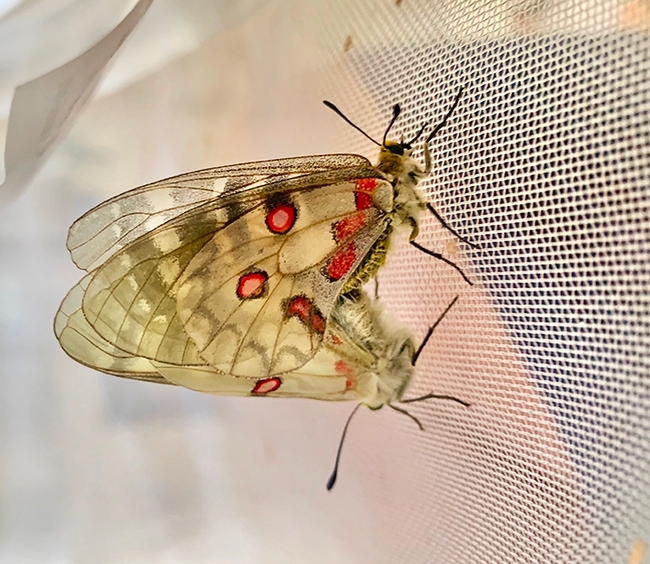- Author: Kathy Keatley Garvey

Ge, who studies with Professor Louie Yang of the Department of Entomology and Nematology and UC Davis Distinguished Professor Art Shapiro of the Department of Evolution and Ecology, researches the American Apollo butterfly (Parnassius clodius) as a model to study how microclimatic conditions affect cold-adapted insects.
Ge will be honored at the annual PBESA meeting, April 2-5 in Seattle, which encompasses 11 Western states, plus Canada and Mexico and U.S. territories. Ge will receive a $1000 award for travel expenses and a waived registration fee. Last year UC Davis student Gwen Erdosh, also of RSPIP and a research scholar with the Yang lab, won the inaugural Garczynski scholarship.
Ge serves as a research assistant with Shapiro's Central California Butterfly Population and Diversity Trends Study. He works with Yang as a project manager and a research assistant on his Milkweed Phenology Study.
“Gary is a remarkable student with an excellent understanding of the butterflies he is studying," said Yang, who researches monarch butterflies and milkweed phenology and nominated Ge for the award. "Over the years, he has applied his longstanding enthusiasm for these butterflies to ask insightful questions about the thermal ecology of cold-adapted organisms under global warming. Gary has also demonstrated the determination and resilience required to overcome unexpected barriers and to see his research through to completion. He is a skilled and thoughtful scientist with the ability to make valuable contributions to ecology, and I've been happy to have had a chance to work with him.”
Ge just finished writing a National Science Foundation's Graduate Research Fellowship Program (GRFP) grant proposal. The results are expected to be announced in April.
His hypothesis: "that mid-elevation populations of P. clodius have the best cold tolerance as overwintering eggs. The main factor behind this is snow cover. Snow cover is known to provide significant insulation to whatever is underneath, usually creating higher microclimatic temperatures under the snow than above. At mid-elevations, the winter temperatures are lower than at low elevations, and the snow cover is supposedly less and more unstable compared to higher elevations. This means the mid-elevation populations are likely exposed to the coldest winter temperature, and have locally adapted to it.”
Ge said he is testing his hypothesis “partly by looking at the supercooling points (SCPs) of diapausing eggs in different populations. The SCP indicates the freezing temperature of the egg, so it should be close to the lower lethal temperature. So, the population with the lowest average SCP would be the most cold-tolerant. I got some preliminary results recently indicating the SCP of the mid-elevation eggs is around -30 °C, which is pretty cold! On the side I am also testing the egg SCP of a Parnassius behrii population. This is a California endemic. It would be cool to see how their thermal tolerance differ from that of P. clodius as P. behrii is only found in high-elevation habitats (mostly around and above 9,000 feet).”
“The genus Parnassius is prone to global warming due to its affinity for alpine and arctic habitats, and several species are considered to be threatened," Ge said.
Shapiro, who has monitored butterfly populations across central California for the last 50 years, says that “Parnassians are a group of cold-adapted Northern Hemisphere butterflies that are becoming increasingly important as objects of physiological, ecological and evolutionary study. They are only likely to grow more important in the context of climate change. Thus, Gary's study is very timely and should attract plenty of attention! It is demanding given the rigorous conditions in which they breed and develop, and he is likely to learn a lot that will facilitate future lab and field studies.”
On his research website, Art's Shapiro's Butterfly site, Shapiro says that P. clodius is “common to abundant Lang Crossing up to Castle Peak; not at Sierra Valley. Common at Washington, near the lower elevational limit of its range. Higher-altitude specimens are consistently smaller than at Washington and Lang. The male of this species generates a large waxy vaginal plug (the sphragis) that prevents the female from mating again (though other males do try). It does not, of course, interfere with egg-laying! Both sexes visit Yerba Santa, Coyotemint, and a wide variety of other flowers. At lower elevations this is a typical species of cool, mesic mixed forest, often along streamsides and at the bases of cliffs. At higher elevations it occurs in moist conifer forest and along streams and the edges of meadows. It does not hilltop. One brood, May-June (low) and June-August (rarely later) (high). Larval host plant Bleeding Heart, genus Dicentra (Fumariaceae, now put in Papaveraceae). Larvae are crepuscular-nocturnal except on cloudy, cool days and mimic poisonous millipedes.”
Research Scholars Program in Insect Biology (RSPIB). Co-founded and directed by Professors Jay Rosenheim, Joanna Chiu and Yang, RSPIB helps students learn cutting-edge research through close mentoring relationships with faculty. The program, launched in 2011, crosses numerous biological fields, including population biology; behavior and ecology; biodiversity and evolutionary ecology; agroecology; genetics and molecular biology; biochemistry and physiology; entomology; and cell biology. The goal: to provide academically strong and highly motivated undergraduates with a multi-year research experience that cultivates skills that will prepare them for a career in biological research.
Ge, born in Beijing, China, attended elementary school in New York City, middle school in Singapore, and high school in Hawaii, and now California for college. “This allowed me to have experience with a range oflepidopterans and ants and termites as well—social insects are my other favorite group.” He anticipates receiving his bachelor of science degree at UC Davis this year and hopes to enroll in graduate school at UC Davis.
He developed his passion for Parnassius during middle school. “When I was visiting my extended family in Tibet, I saw this small white butterfly flying through the seemingly lifeless alpine scree habitat at an elevation of around 1,5000 feet. I later found out that it was a Parnassius species and got immediately intrigued by the fact that they are mostly specialist of alpine and arctic habitats, living in some of the world's coldest and most hostile environments. Since many of the genus members have habitats restricted to mountain tops above the tree line, our P. behrii is an example, climate change--rising tree lines-would leave them nowhere to go. This makes better understanding the ecology of this genus utterly important.”
The scholarship memorializes Stephen Garczynski (1960-2019), a research geneticist at the USDA Agricultural Research Service in Wapato, Wash.,"who had an unmatched passion for mentoring undergraduate students in their research," according to the PBESA website. "Steve helped students by serving as a role model with his contagious energy and drive, his ability to teach and convey his scientific knowledge, and by encouraging students to be creative and innovative in their work. The purpose of this merit-based award is to honor students for their accomplishments in research, and to support and encourage them to present their work at a branch or national ESA meeting."



